Abstract
Hardpan is one of the major problems found in many parts of Thailand where monocropping and repeated plowing at the same depth are conducted. This work aimed to study the feasibility of using crumb rubber produced from waste tires to alleviate the soil compaction problem. Effects of particle size and loading of crumb rubber on the degree of soil compaction were investigated. The quality of water extracted from crumb rubber was also analyzed to determine the severity of environmental contamination. The scope of work was further extended into field tests. The results reveal that the addition of crumb rubber into sandy loam subsoil significantly reduced the bulk density of the compacted soil and permitted greater water permeation through the compacted soil layer. The effects were more pronounced with either increasing crumb rubber loading or reducing crumb rubber particle size. For the field test, the addition of small crumb rubber (S-crumb) at 30%wt. resulted in a significant reduction in penetration force in conjunction with a considerable increase in water permeability. The results clearly confirm the reduction in soil compaction by the addition of crumb rubber. From a quality analysis of the extracted water, most poisonous heavy metals were below the detection limits of the test equipment, except zinc.
1. Introduction
Due to the rapid growth of the global tire demand, the number of waste tires has increased continuously, especially during the last few decades. The accumulation of waste tires in huge volumes may cause severe environmental problems unless proper waste management is implemented. Great attempts have therefore been made to recycle these waste tires by using them as a fuel source for power plants and a raw material for tire pyrolysis to produce oil, gas, carbon black, and steel wire [1,2,3,4]. In addition, after the separation of steel and fibers, waste tires can be ground into very small particles, widely known as crumb rubber. Apart from being used as a cost-reduction filler for many rubber products and as a raw material for reclaimed rubber production, the crumb rubber has also been widely used as a filler in other polymers for a variety of applications, e.g., sports fields, railway level crossing panels, railroad sleeper, pavement, road construction, etc. [5,6,7,8,9]. Despite the vast applications of recycled crumb rubber, as aforementioned, attention has also been given to the utilization of waste plastic and crumb rubber for geotechnical applications [10,11,12]. It has recently been revealed that the waste of polypropylene plastic could be used as a reinforcing additive in lateritic soils, which are generally used as paving materials in Southeast Asia [10]. Furthermore, it has been reported that crumb rubber can be used to improve porosity and reduce the compaction of topsoil [12]. It is, therefore, interesting to investigate the feasibility of using crumb rubber to lower the soil compaction and, thus, alleviate the hardpan problems.
Soil is generally known as one of the most important compositions for cultivation. Crop productivity is greatly dependent on soil quality, which is determined by many factors, all of which affect fertility. High-quality soil generally yields the rapid growth of crops without the need for excessive nutrient addition. Poor soil quality is undesirable and often arises from one or a combination of these activities, i.e., inadequate fertilization, lack of crop rotation, and over-farming of the same land. In Thailand, monocropping is one of the major causes of soil problems, particularly in the highlands where sugarcane or cassava cropping is conducted. The utilization of repeated plowing and heavy machines for land preparation and product transportation also greatly deteriorates the physical condition of the soil as it causes soil compaction and finally leads to the occurrence of hardpan which is usually found below the uppermost topsoil layer [13,14,15,16,17]. Soil compaction greatly reduces pore space for air and water, known as soil pores [18]. As these pores are the areas where plant roots grow and water flows through the soil, soil compaction, therefore, induces many problems, including poor water percolation, high risk of soil erosion, restricted plant root growth, and lower crop yields [19,20]. The formation of a hardpan near the soil surface not only effectively reduces the usable soil depth but also induces waterlogging in heavy rains and a shortfall of water or moisture during the drought condition [13,15]. Hardpan problems can be alleviated by soil amendments and the use of mechanical means such as deep ripping, digging, or plowing by the digging fork or chisel plow with the help of a tractor [13,21]. The addition of organic matter, e.g., manure or compost, including crop residues, can improve water drainage, stabilize soil structure, and enhance earthworm proliferation that can, over time, decrease the bulk density of soil [22,23,24,25,26]. The adjustment of soil pH with lime (for acidic soil) and the addition of gypsum, coal, and fly ash may also improve hardpans [26,27,28]. However, unlike mechanical means, the destruction of a hardpan through soil amendments may require continuous action over a long period of time. Although deep ripping is often used to destroy the hardpan layer and increases the water infiltration rate, the effect of this action alone lasts only for the first three years because the large soil voids created by ripping will be gradually filled with fine particles and the soil will finally be compacted again [29]. Many attempts have therefore been made to achieve a long-term solution to this problem. So far, the application of crumb rubber to solve the hardpan problem has not been revealed. It is, therefore, the aim of this study to investigate the possibility of using crumb rubber as a soil additive to prevent soil compaction. The effects of particle size and loading of crumb rubber on dry bulk density and water permeation rate of hardpan were investigated and discussed. In addition, the quality of the water extracted from the crumb rubber sample was evaluated to determine short-term environmental safety.
2. Materials and Methods
2.1. Materials
In this study, the soil sample was collected from Nakhon Ratchasima province, Thailand (15°06′048″ N, 102°13′043″ E). Approximately 50 cm of the topsoil was taken out by a tractor before the sample collection. The soil in this area is classified as sandy loam soil. Three recycled rubber samples produced from waste tires, i.e., two crumb rubber samples (designated as S-crumb and M-crumb) and one shredded rubber sample (designated as L-crumb), were purchased from Continental Platform Co., Ltd., Mae Wang, Chiang Mai (Thailand). Figure 1 shows photographs of the crumb rubber samples used in this study. The basic properties of the three samples are given in Table 1.
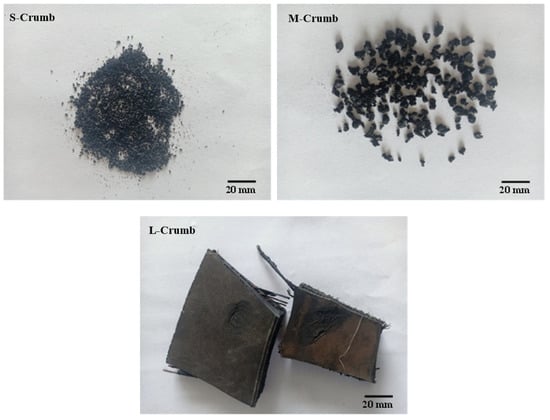
Figure 1.
Photographs of the crumb rubber samples.

Table 1.
Properties of the crumb rubber samples.
2.2. Characterization of the Soil Sample
The soil sample was initially dried in an oven at 100 °C for 24 h before being pulverized and screened through a 10-mesh sieve to obtain soil with particle size less than 2 mm. Particle size distribution of the soil was then characterized by the sieving method (using 50-mesh, 100-mesh, and 200-mesh sieves) together with the sedimentation method in accordance with ISO 11277:2020 [30]. The soil pH was measured, as per ISO 10390:2005 [31], by using a pH meter (model PH700; Apera Instruments, Shanghai, China). The soil, 30 g, was mixed with 100 mL of deionized water under a continuous stirring for 60 min before the pH measurement. The dry bulk density of the soil sample was determined by the procedures described in ISO 11272:2017 [32].
2.3. Preparation of the Compacted Soils
To simulate the occurrence of hardpan and study the effect of moisture content in soil on hardpan formation, the completely dried soil sample was added with various water contents ranging from 2 to 10%wt., thoroughly mixed by a laboratory planetary mixer (Sirman model LKK1-B15(K), Wuxi, China) at 10 rpm for 10 min. The soil samples with different moisture contents were then compressed in a mold under the pressure of 85.5 MPa in order to form the cylindrical compacted soil specimens with a diameter and height of 101.6 mm and 116.4 mm, respectively. The dry bulk density of the compacted soil specimens was subsequently determined by the procedures described in ISO 11272:2017.
2.4. Properties of the Compacted Soils Filled with Crumb Rubber Samples
In this section, the effects of particle size and loading of crumb rubber on bulk density and water permeability of the compacted soil were investigated. The optimum moisture content providing the compacted soil with the highest bulk density obtained from the previous section was used for the sample preparation. The dried soil sample was mixed with water (7%wt.) and various loadings of crumb rubber samples, as shown in Table 2. Mixing was carried out by using the mechanical blender at 10 rpm for 10 min. The well-mixed samples were then pressed under a pressure of 85.5 MPa to form the cylindrical compacted soil specimens.

Table 2.
Recipes used in this study.
The dry bulk density of the compacted specimens was measured according to ISO 11272:2017. As rubber is an incompressible material, its volume remains constant after compaction. Hence, the actual bulk density of the soil matrix in the compacted specimens, indicating the degree of soil compaction, can be calculated using Equation (1). Water permeation was also measured using a permeameter (Soil Testing Siam, Bangkok, Thailand) under constant head conditions at 16.2 kPa following ISO 17892-11:2019 [33].
where
ρs = bulk density of the soil;
ρf = bulk density of the filled specimen;
ρr = density of crumb rubber;
Vs = volume fraction of soil in the specimen;
Vr = volume fraction of crumb rubber in the specimen.
2.5. Determination of Contaminated Water Quality
As the crumb rubber samples contain many compounding ingredients that could be released or leached into the environment during their service life in the soil, the quality of the water obtained from crumb rubber extraction was therefore determined. In this section, the S-crumb sample (1250 g) was immersed in 5 L of deionized water and kept at 70 °C for 14 days. After filtration, the filtrate was determined for the contamination of calcium carbonate, anions, and heavy metals by using inductively coupled plasma (ICP, Shimadzu model ICPMS-2030 Kyoto, Japan) and ion chromatography (IC, Thermo Scientific model IC-Dionex ICS-1100, Waltham, MA, USA) techniques. For ICP analysis, the filtrate was diluted 10-fold for zinc analysis and 100-fold for all other elements using ultrapure water prior to being tested. Mineral contents were quantified according to a calibration curve created using accurately diluted standard solutions. For IC analysis, the IonPac AS11 column, safeguarded by an IonPac AG11 guard column, was used for separation. The eluent flow rate was 1.0 mL/min. The equipment was connected to a model Ultimate 3000 RS fluorescence detector (Dionex, Sunnyvale, CA, USA). Data collection and analysis were performed using the Chromeleons™ 7.2 software (Thermo Fisher Scientific, Waltham, MA, USA).
2.6. Application of Crumb Rubber in the Field Test
After gathering the data from the laboratory test, the experiment was extended to the field test, carried out at Nakorn Ratchasima province (15°06′048″ N, 102°13′043″ E). This area was selected due to the natural existence of a hardpan at approximately 40–50 cm below the soil surface. The selected farmland with an approximate area of 400 m2 was divided into 3 adjacent plots, as shown in Figure 2. No land preparation was carried out in the first plot. In the second and the third plots, a tractor equipped with a long ripper (50 cm depth), see Figure 3a, was used to destroy the existing hardpan. This process is generally called subsoil plowing. Thereafter, four holes with approximate dimensions of 1 × 1 × 1 m3 were dug, as shown in Figure 3b. In the second plot, the dug-up soil was re-filled into the holes without the addition of the crumb rubber. Moreover, in the third plot, some of the dug-up soil was mixed thoroughly with 30%wt. of S-crumb, see Figure 3c, and added into the holes until the holes were half filled. The top half of the holes was subsequently filled by the dug-up soil (topsoil). Agricultural activities were then carried out by plowing and tilling the selected areas with heavy machinery. Water was later sprayed all over the areas through a springer system until approximately 7%wt. of moisture content was attained. A large tractor (Ford 6640 90HP, Fargo, ND, USA) was driven over the selected areas 10 times. These agricultural activities were repeated 5 times every 15 days intervals to ensure the formation of soil compaction. In the end, the topsoil (50 cm depth) of all plots was taken out by the tractor before measuring the properties of the compacted soil at the hole locations (for Plot No. 2 and Plot No. 3).
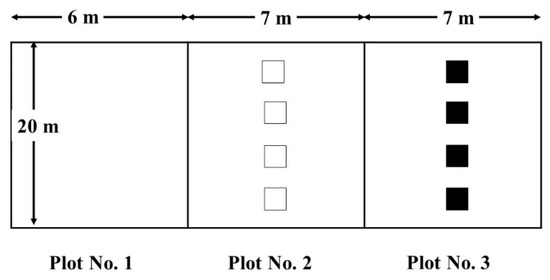
Figure 2.
Scheme of the field-tested area.
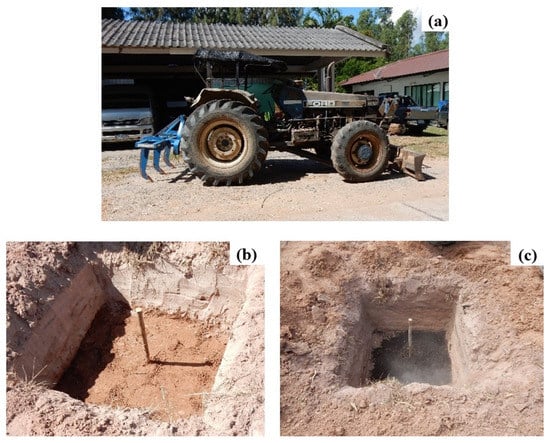
Figure 3.
Field test study: (a) a tractor equipped with a long ripper, (b) the bottom half of the hole filled with dug-up soil, and (c) the bottom half of the hole filled with a mixture of dug-up soil and S-crumb.
Penetration resistance of the compacted soil was determined by a handheld electronic cone penetrometer (FieldScout model SC 900, Chicago, IL, USA) based on the procedures described in the American Society of Agricultural Engineers standards (ASAE S313.3:2004 and EP542:1999). The cone was inserted into the ground at a constant speed of 30 mm/s before recording the amount of force exerted over the cone’s surface area. The results are represented in terms of cone index (CI). The water permeation rate through the compacted soil was evaluated by a double-ring infiltrometer (ELE International, Kiln Farm, UK) according to ISO 22282-5:2012 [34].
3. Results and Discussion
3.1. Characterization of the Soil Sample
From the measurement of the basic properties of the soil sample, it was found that bulk density before the non-compaction and pH of the soil was 1.48 g/cm3 and 7.22, respectively. The obtained bulk density falls in the normal range for sandy loam soil, as it has been reported that the bulk density of sandy loam soil is generally between 1.4 and 1.5 g/cm3 [35]. Figure 4 displays the particle size distribution of the soil sample. Apparently, approximately 95% of the soil had a particle size in the range of 75–300 mm, indicating the majority of sand particles in the soil.
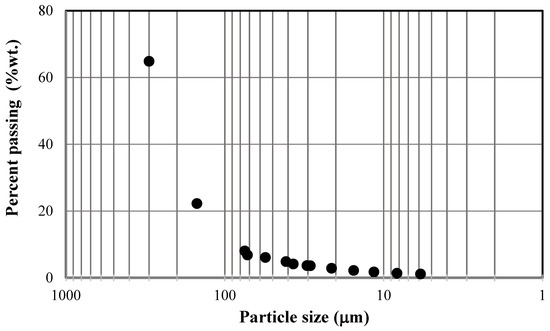
Figure 4.
Particle size distribution of the soil.
3.2. Preparation of the Compacted Soils
Figure 5 displays the bulk density of the compacted soils as a function of water content. Obviously, the bulk density of the compacted soil has 2%wt. of water content was 1.77 g/cm3, which is significantly higher than that of the uncompacted soil (1.48 g/cm3). The results clearly indicate the formation of a hardpan after the compaction because it is reported that the density of the hardpan is greater than 1.6 g/cm3 [36]. It can also be observed that the bulk density of the compacted soil initially increased with increasing water content up to 7%wt. and tended to decrease afterward. Generally, dry soil contains soil particles that are not in contact leading to high void volumes and, hence, low bulk density. In the presence of water, the thin water film formed around each soil particle provides a lubricating effect and facilitates the compaction of the soil particles when subjected to high pressure resulting in an initial increase in the bulk density with increasing water content. In this study, the optimum water content giving the highest bulk density of the compact soil (~1.95 g/cm3) is 7%wt. In the presence of excessive water (≥8%wt.), there is no more air volume for water to fill in, and thus, the water will occupy the extra space and behave as a matrix in the system leading to weakened soil compaction. To confirm the occurrence of hardpan after the compaction, a water permeability test was carried out, and it was found that all compacted samples were water impermeable.
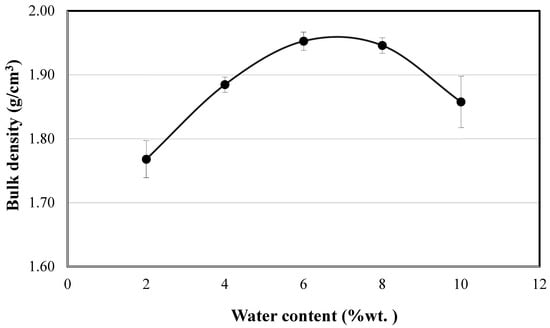
Figure 5.
Bulk density of the compacted soils at various water contents.
3.3. Properties of the Compacted Soils Filled with Crumb Rubber Samples
As previously mentioned, great attempts have been made to improve water permeation through a hardpan layer or reduce the subsoil compaction by using various methods [22,28,37]. This study proposed an alternative method to reduce the degree of soil compaction and alleviate the waterlogging problem from the occurrence of a hardpan layer by adding various sizes and loadings of crumb rubber into the subsoil. Figure 6 displays the calculated bulk density of the soil matrix after normalization. Clearly, the bulk density of the compacted soil matrix diminished gradually with increasing crumb rubber loading for all crumb rubber samples indicating the reduction in soil compaction in the presence of crumb rubber. This can be explained by the energy absorption of crumb rubber. Under compressive pressure, the crumb rubber, which can be considered as a filler in soil, could deform and partially absorb the input energy leading to reduced stress acting on the soil matrix. As a result, the bulk density of the soil matrix in the compacted samples tended to decrease with increasing crumb rubber loading. At any given crumb rubber loading, L-crumb showed the highest bulk density of the soil matrix, followed by M-crumb and S-crumb, respectively. The results clearly indicate the dependence of the bulk density of the soil matrix on the particle size of the crumb rubber, i.e., the smaller the particle size of the crumb rubber, the greater the magnitude of bulk density reduction. The results imply that smaller crumb rubber is more effective in energy absorption than larger crumb rubber. Although the addition of L-crumb and M-crumb can reduce the bulk density of the compacted soil to some extent, the obtained values are still higher than the threshold bulk density of hardpan (1.6 g/cm3). Only the addition of S-crumb provides bulk density lower than 1.6 g/cm3, even at 20%wt. The results confirm that the addition of S-crumb into the subsoil, at sufficient loading, can diminish the hardpan formation and thus alleviate the waterlogging problem.
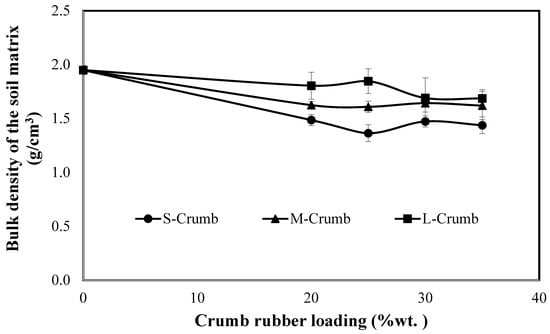
Figure 6.
Bulk density of the soil matrix in the unfilled and filled specimens.
Without crumb rubber, the bulk density of the compacted soil is very high (1.95 g/cm3), which completely impedes the water permeation through this hardpan layer leading to a high risk of waterlogging problems during heavy rains. To ensure the alleviation of this problem by the addition of crumb rubber, a water permeability test was carried out, and the results are demonstrated in Figure 7. From the results, the water permeation rate increased with increasing crumb rubber loading regardless of the crumb rubber particle size. The enhanced water permeation rate is thought to arise from the reduction in soil compaction, as evidenced by the reduced bulk density. Moreover, the poor interfacial interaction between non-polar crumb rubber particles and soil might also contribute to greater water permeation. As expected, at the same crumb rubber loading, the water permeation rate increased with decreasing particle size of the crumb rubber. Again, this could be explained by the greater ability to reduce bulk density of the soil matrix and the higher specific surface area, defined as the total surface area per unit of mass, of the smaller crumb rubber.
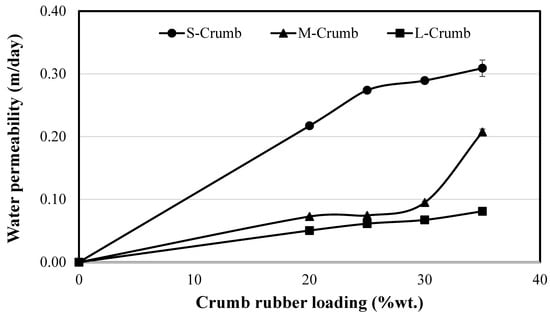
Figure 7.
Water permeability of the unfilled and filled compacted soils.
3.4. Determination of Contaminated Water Quality
With great concern about water contamination arising from the addition of crumb rubber into the soil, an experiment was carried out by soaking the S-crumb sample in water for 14 days at 70 °C, and the leached chemicals were analyzed. Table 3 shows a list of chemicals found in the filtrate. It could be seen that, when compared with the specification of drinking water standards of the Department of Health, Ministry of Public Health (Thailand), the quantities of calcium carbonate, ions, and most heavy metals were far below the maximum limits of the standard despite the utilization of severe extracting conditions. Concentrations of many toxic heavy metals such as copper, chromium, cadmium, arsenic, and mercury were very low (below the detection limits of the test equipment). An exception was given to zinc because the filtrate contained approximately 12 times higher than the maximum limit. This is not beyond expectation because crumb rubber contains a relatively large amount of zinc oxide (ZnO), which is commonly added to rubber during tire production to activate the vulcanization reaction [38,39,40,41]. Even though ZnO is not very poisonous to humans, it negatively impacts aquatic ecosystems, particularly the nanoparticle ZnO which can be ingested by marine animals, including coral, causing internal damage [42]. In addition, the nanoparticle ZnO in the ocean can react with ultraviolet rays to generate hydrogen peroxide, which is highly toxic to phytoplankton, a main nutrient source for many reef and coral species [43]. In this study, contamination of zinc in soil is of great concern. For soil, the toxicity data of zinc and zinc compounds on invertebrates, plants, and microorganisms have been revealed, i.e., the nominal no observed effect concentration (NOEC) values, defined as the highest concentration that does not cause a toxic effect, range from 17 to 2623 mg/kg (dry weight of soil) for microorganisms, 32 to 1000 mg/kg dry weight for invertebrate species and 32 to 400 mg/kg dry weight for plants [44]. According to extensive surveys, the quantity of zinc in the soil is generally in the range of 10–300 ppm [45]. The amount of zinc released from S-crumb, under severe extraction, into the soil may cause toxicity to some species of microorganisms, invertebrates, and plants. However, this is unlikely to occur in practice because zinc may be leached slowly with time and absorbed by plants to produce chlorophyll and enzymes [46]. In addition, it has been reported that sandy and highly leached acid soils, including soils with low organic matter, generally have low zinc loading [47]. The addition of S-crumb into the sandy loam soil having low organic matter, which is prone to hardpan formation, might therefore be beneficial for plant growth. Further study, however, is needed to investigate the long-term effect of crumb rubber addition on the toxicity of the soil.

Table 3.
Water quality after the extraction.
3.5. Application of Crumb Rubber in the Field Test
Practically, the degree of soil compaction in the field test is measured by the penetration resistance test. In this study, the handheld electronic cone penetrometer was used to measure the degree of soil compaction after the 50 cm topsoil was taken out. The obtained results are given in Figure 8. The penetration force tended to increase with increasing penetration depth of soil. It could be observed that the highest penetration force was found in Plot No. 1, where the naturally occurring hardpan existed. In this plot, measurement of the penetration force could be performed up to only 15 cm of soil depth due to the high magnitude of soil compaction. A significant reduction in penetration force was observed for Plot No. 2, where the naturally occurring hardpan was initially destroyed and subsequently reformed by simulated agricultural activities. The results imply that the degree of soil compaction of Plot No. 2 is lower than that of Plot No. 1. Corresponding well with the laboratory results, the addition of crumb rubber can effectively reduce the degree of soil compaction as can be seen from the further reduction in penetration force in Plot No. 3, where the natural hardpan was destroyed and reformed in a similar manner to Plot No. 2 but the subsoil was mixed with 30%wt. of S-crumb before the reformation. With a lower soil compaction degree, the addition of S-crumb, therefore, offers higher soil porosity which is advantageous for root growth of many plants [48].
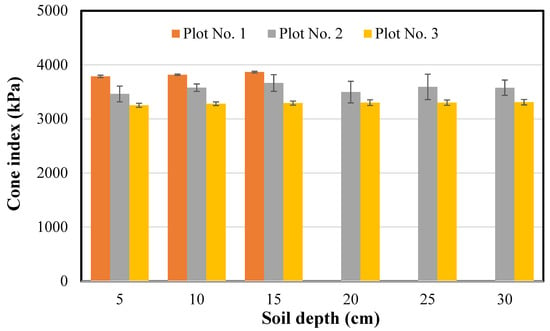
Figure 8.
Cone index at various depths of the compacted soils.
In addition, the greater soil porosity also results in a higher water permeation rate, as shown in Figure 9. The water permeation rate, measured from a double-ring infiltrometer, of the naturally occurring hardpan in Plot No. 1 was the lowest, which is in good agreement with the penetration resistance results, as previously mentioned. As can be expected, the water permeation rate of Plot No. 2 was slightly higher than that of Plot No. 1 but significantly lower than that of Plot No. 3. Compared with Plot No. 2, the water permeation rate of Plot No. 3 is almost two-fold higher confirming the beneficial effects of the crumb rubber addition.
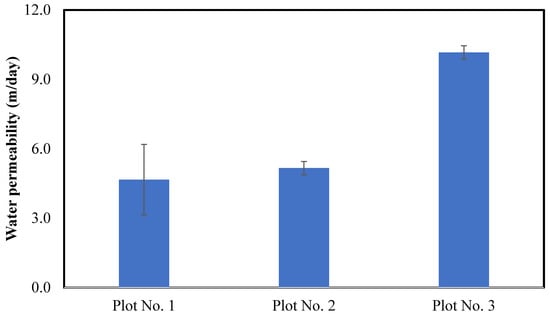
Figure 9.
Water permeation rate of various plots.
4. Conclusions
Crumb rubber produced from waste tires can be used to reduce the degree of soil compaction and, thus, alleviate the formation of a hardpan layer underneath the plowing level. Its efficacy depends greatly on the particle size, i.e., the smaller particle size gives higher efficacy in energy absorption and, hence, provides a greater reduction in soil compaction as evidenced by the lower bulk density of the soil matrix and the greater water permeation rate. In this study, S-crumb was selected for the field test, and the results from the field test showed the same trend as those obtained from the laboratory test. The addition of crumb rubber significantly reduced the degree of soil compaction, as can be seen from the considerable reduction in the penetration force and the large increase in water permeability. The release of zinc oxide from crumb rubber and microplastic issues, however, must be taken into consideration before implementation. A long-term study on the effect of crumb rubber addition on soil properties and toxicity is also needed.
Author Contributions
Conceptualization and methodology, S.L., S.P. and T.N.-L.; investigation, S.P., T.N.-L. and T.K.; writing—original draft preparation, S.P.; writing—review and editing, P.S.-O.; visualization, P.S.-O. and T.K.; project administration, S.L. and S.P.; supervision, P.S.-O. All authors have read and agreed to the published version of the manuscript.
Funding
This research received no external funding.
Institutional Review Board Statement
Not applicable.
Informed Consent Statement
Not applicable.
Data Availability Statement
The data presented in this study are available on request from the corresponding author.
Acknowledgments
We would like to thank the Land Development Regional Office, Nakorn Ratchasima, Thailand, for supporting the field-testing area and other testing facilities.
Conflicts of Interest
The authors declare that there are no conflict of interest regarding the publication of this paper.
References
- Djandja, O.S.; Wang, Z.; Duan, P.; Wang, F.; Xu, Y. Hydrotreatment of pyrolysis oil from waste tire in tetralin for production of high-quality hydrocarbon rich fuel. Fuel 2021, 285, 119185. [Google Scholar] [CrossRef]
- Farzad, S.; Mandegari, M.; Gorgens, J.F. A novel approach for valorization of waste tires into chemical and fuel (limonene and diesel) through pyrolysis: Process development and techno economic analysis. Fuel Process. Technol. 2021, 224, 107006. [Google Scholar] [CrossRef]
- Idris, R.; Chong, C.T.; Ani, F.N. Microwave-induced pyrolysis of waste truck tyres with carbonaceous susceptor for the production of diesel-like fuel. J. Energy Inst. 2019, 92, 1831–1841. [Google Scholar] [CrossRef]
- Karagöz, M. Investigation of performance and emission characteristics of an CI engine fuelled with diesel—Waste tire oil—Butanol blends. Fuel 2020, 282, 118872. [Google Scholar] [CrossRef]
- Farhan, A.H.; Dawson, A.R.; Thom, N.H. Compressive behaviour of rubberized cement-stabilized aggregate mixtures. Constr. Build. Mater. 2020, 262, 120038. [Google Scholar] [CrossRef]
- Groenevelt, P.H.; Grunthal, P.E. Utilisation of crumb rubber as a soil amendment for sports turf. Soil Tillage Res. 1998, 47, 169–172. [Google Scholar] [CrossRef]
- Hamada, K.; Inoue, H.; Mochizuki, H.; Miyamoto, T.; Asakura, M.; Shimizu, Y. Effect of hardpan on the vertical distribution of water stress in a converted paddy field. Soil Tillage Res. 2021, 214, 105161. [Google Scholar] [CrossRef]
- Wang, Q.Z.; Wang, N.N.; Tseng, M.L.; Huang, Y.M.; Li, N.L. Waste tire recycling assessment: Road application potential and carbon emissions reduction analysis of crumb rubber modified asphalt in China. J. Clean. Prod. 2020, 249, 119411. [Google Scholar] [CrossRef]
- Yu, P.; Manalo, A.; Ferdous, W.; Abousnin, R.; Salih, C.; Heyer, T.; Schubel, P. Investigation on the physical, mechanical and microstructural properties of epoxy polymer matrix with crumb rubber and short fibres for composite railway sleepers. Constr. Build. Mater. 2021, 295, 123700. [Google Scholar] [CrossRef]
- Marçal, R.; Lodi, P.C.; Correia, N.D.S.; Giacheti, H.L.; Rodrigues, R.A.; McCartney, J.S. Reinforcing Effect of Polypropylene Waste Strips on Compacted Lateritic Soils. Sustainability 2020, 12, 9572. [Google Scholar] [CrossRef]
- Tasalloti, A.; Chiaro, G.; Murali, A.; Banasiak, L. Physical and Mechanical Properties of Granulated Rubber Mixed with Granular Soils—A Literature Review. Sustainability 2021, 13, 4309. [Google Scholar] [CrossRef]
- Robert, C.M.; Parviz, N.S.; Jan, E.C. Soil amendment with rubber particles. United State Patent 5,014,462, 14 May 1991. [Google Scholar]
- Batey, T. Soil compaction and soil management-a review. Soil Use Manag. 2009, 25, 335–345. [Google Scholar] [CrossRef]
- Shaheb, M.R.; Venkatesh, R.; Shearer, S.A. A review on the effect of soil compaction and its management for sustainable crop production. Biosyst. Eng. 2021, 46, 417–439. [Google Scholar] [CrossRef]
- Soane, B.D.; van Ouwerkerk, C. Soil Compaction in Crop Production, 1st ed.; Elsevier Science B.V.: Amsterdam, The Netherlands, 1994; pp. 1–22. [Google Scholar]
- Zabrodskyi, A.; Šarauskis, E.; Kukharets, S.; Juostas, A.; Vasiliauskas, G.; Andriušis, A. Analysis of the Impact of Soil Compaction on the Environment and Agricultural Economic Losses in Lithuania and Ukraine. Sustainability 2021, 13, 7762. [Google Scholar] [CrossRef]
- Xiao, Z.; Yu, N.; An, J.; Zou, H.; Zhang, Y. Soil Compressibility and Resilience Based on Uniaxial Compression Loading Test in Response to Soil Water Suction and Soil Organic Matter Content in Northeast China. Sustainability 2022, 14, 2620. [Google Scholar] [CrossRef]
- Ramos, M.F.; Almeida, W.R.d.S.; Amaral, R.d.L.d.; Suzuki, L.E.A.S. Degree of compactness and soil quality of peach orchards with different production ages. Soil Tillage Res. 2022, 219, 105324. [Google Scholar] [CrossRef]
- Bengough, A.G.; McKenzie, B.M.; Hallett, P.D.; Valentine, T.A. Root elongation, water stress, and mechanical impedance: A review of limiting stresses and beneficial root tip traits. J. Exp. Bot. 2011, 62, 59–68. [Google Scholar] [CrossRef]
- Yue, L.; Wang, Y.; Wang, L.; Yao, S.; Cong, C.; Ren, L.; Zhang, B. Impacts of soil compaction and historical soybean variety growth on soil macropore structure. Soil Tillage Res. 2021, 214, 105166. [Google Scholar] [CrossRef]
- Hamzaa, M.A.; Anderson, W.K. Soil compaction in cropping systems A review of the nature, causes and possible solutions. Soil Tillage Res. 2005, 82, 121–145. [Google Scholar] [CrossRef]
- Busscher, W.J.; Novak, J.M.; Ahmedna, M. Physical effects of organic matter amendment of a southeastern US coastal loamy sand. Soil Sci. 2011, 176, 661–667. [Google Scholar] [CrossRef]
- Carter, M.R. Soil quality for sustainable land management: Organic matter and aggregation interactions that maintain soil functions. Agron. J. 2002, 94, 38–47. [Google Scholar] [CrossRef]
- Thomas, G.W.; Haszler, G.R.; Blevins, R.I. The effect of organic matter and tillage on maximum compatibility of soils using the proctor test. Soil Sci. 1996, 161, 502–508. [Google Scholar] [CrossRef]
- Tim Chamen, W.C.; Moxey, A.P.; Towers, W.; Balana, B.; Hallett, P.D. Mitigating arable soil compaction: A review and analysis of available cost and benefit data. Soil Tillage Res. 2015, 146, 10–25. [Google Scholar] [CrossRef]
- Fang, J.; Zeng, D.; Tian, X.; Duwal, K.B. Soil Compaction Mechanism and Improvement in Farmland. Sustainability 2023, 15, 6801. [Google Scholar] [CrossRef]
- Chang, A.C.; Lund, L.J.; Page, A.L.; Warneke, J.E. Physical properties of fly ash-amended soils. J. Environ. Qual. 1977, 6, 267–270. [Google Scholar] [CrossRef]
- Murphy, P.N.C.; Stevens, R.J. Lime and gypsum as source measures to decrease phosphorus loss from soils to water. Water Air Soil Pollut. 2010, 212, 101–111. [Google Scholar] [CrossRef]
- Wang, Y.; Amundson, R.; Niu, X.F. Seasonal and altitudinal variation in decomposition of soil organic matter inferred from radiocarbon measurements of soil CO2 flux. Glob. Biogeochem. Cycles 2000, 14, 199–211. [Google Scholar] [CrossRef]
- ISO 11277-2020; Soil Quality—Determination of Particle Size Distribution in Mineral Soil Material—Method by Sieving and Sedimentation. International Organization for Standardization: Geneva, Switzerland, 2020.
- ISO 10390-2017; Soil Quality—Determination of pH. International Organization for Standardization: Geneva, Switzerland, 2017.
- ISO 11272-2017; Soil Quality—Determination of Dry Bulk Density. International Organization for Standardization: Geneva, Switzerland, 2017.
- ISO 17892-11-2019; Geotechnical Investigation and Testing—Laboratory Testing of Soil—Part 11: Permeability Tests. International Organization for Standardization: Geneva, Switzerland, 2019.
- ISO 22282-5-2012; Geotechnical Investigation and Testing—Geohydraulic Testing—Part 5: Infiltrometer Tests. International Organization for Standardization: Geneva, Switzerland, 2012.
- Meek, B.D.; Rechel, E.A.; Carter, L.M.; Tar, W.R.D. Soil compaction and its effect on alfalfa in zone production systems. Soil Sci. Soc. Am. J. 1988, 51, 233–236. [Google Scholar] [CrossRef]
- Tekeste, M.Z.; Raper, R.L.; Schwab, E.B. Soil Drying effects on soil strength and depth of hardpan layers as determined from cone index data. Agric. Eng. Inter. 2008, 10, 1–17. [Google Scholar]
- Ekwue, E.I.; Stone, R.J. Organic matter effects on the strength properties of compacted agricultural soils. Am. Soc. Agric. Eng. 1995, 38, 357–365. [Google Scholar] [CrossRef]
- Heideman, G.; Noordermeer, J.; Baarle, B.V. Effect of Zinc complexes as activator for sulfur vulcanization in various rubbers. Rubber Chem. Technol. 2005, 78, 245–257. [Google Scholar] [CrossRef]
- Mark, J.E.; Erman, B.; Roland, M. The Science and Technology of Rubber, 4th ed.; Elsevier: Boston, MA, USA, 2013; pp. 449–454. [Google Scholar]
- Thaptong, P.; Boonbumrung, A.; Jittham, P.; Sae-oui, P. Potential use of a novel composite zinc oxide as eco-friendly activator in Tire tread compound. J. Polym. Res. 2019, 26, 226. [Google Scholar] [CrossRef]
- Boopasiri, S.; Sae-Oui, P.; Siriwong, C. Fabrication of microcrystalline cellulose/zinc oxide hybrid composite by hydrothermal synthesis and its application in rubber compounding. J. Appl. Polym. Sci. 2021, 139, 25065. [Google Scholar] [CrossRef]
- Baker, T.J.; Tyler, T.R.; Galloway, T.S. Impacts of metal and metal oxide nanoparticles on marine organisms. Environ. Pollut. 2014, 186, 257–271. [Google Scholar] [CrossRef] [PubMed]
- Sanchez-Quiles, D.; Tovar-Sanchez, A. Sunscreens as a Source of Hydrogen Peroxide Production in Coastal Waters. Environ. Sci. Technol. 2014, 48, 9037–9042. [Google Scholar] [CrossRef] [PubMed]
- Bodar, C.W.M. Environmental Risk Limits for Zinc. RIVM letter report 11235/2007. Available online: https://www.google.com.hk/url?sa=t&rct=j&q=&esrc=s&source=web&cd=&cad=rja&uact=8&ved=2ahUKEwiw5KzA986AAxWXqFYBHS3dDcUQFnoECAgQAQ&url=https%3A%2F%2Fwww.rivm.nl%2Fbibliotheek%2Frapporten%2F601782004.pdf&usg=AOvVaw2ZBrY2PSzowVnhliwZtE3e&opi=89978449 (accessed on 9 July 2023).
- Lindsay, W.L. Zinc in soils and plant nutrition. Adv. Agron. 1972, 24, 147–186. [Google Scholar] [CrossRef]
- Samreen, T.; Humaira; Shah, H.U.; Ullah, S.; Javid, M. Zinc effect on growth rate, chlorophyll, protein and mineral contents of hydroponically grown mungbeans plant (Vigna radiata). Arab. J. Chem. 2017, 10, S1802–S1807. [Google Scholar] [CrossRef]
- Zeng, H.; Wu, H.; Yan, F.; Yi, K.; Zhu, Y. Molecular regulation of zinc deficiency responses in plants. J. Plant Physiol. 2017, 261, 153419. [Google Scholar] [CrossRef]
- Lin, L.R.; He, Y.B.; Chen, J.Z. The influence of soil drying- and tillage-induced penetration resistance on maize root growth in a clayey soil. J. Integr. Agric. 2016, 15, 1112–1120. [Google Scholar] [CrossRef]
Disclaimer/Publisher’s Note: The statements, opinions and data contained in all publications are solely those of the individual author(s) and contributor(s) and not of MDPI and/or the editor(s). MDPI and/or the editor(s) disclaim responsibility for any injury to people or property resulting from any ideas, methods, instructions or products referred to in the content. |
© 2023 by the authors. Licensee MDPI, Basel, Switzerland. This article is an open access article distributed under the terms and conditions of the Creative Commons Attribution (CC BY) license (https://creativecommons.org/licenses/by/4.0/).